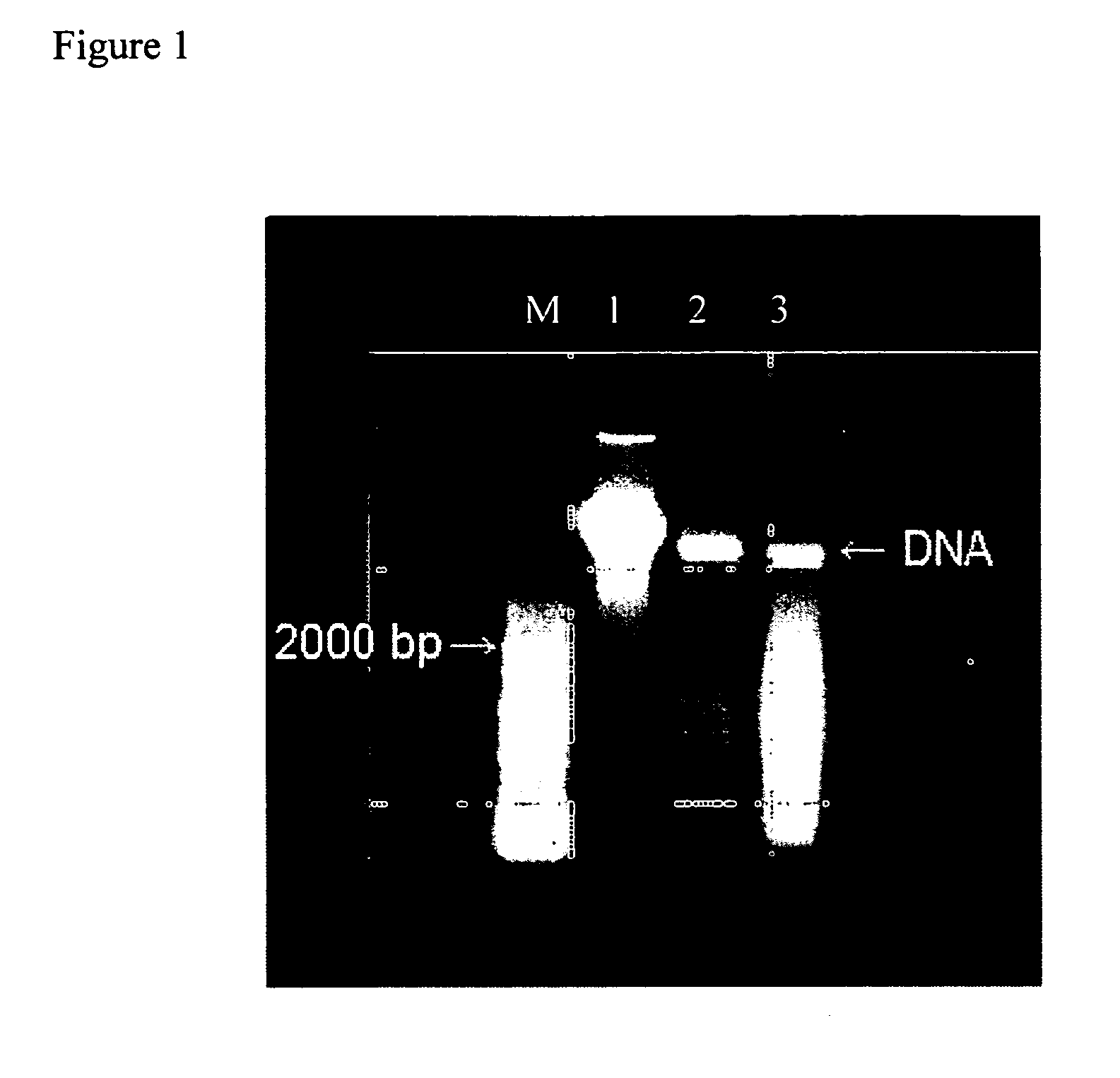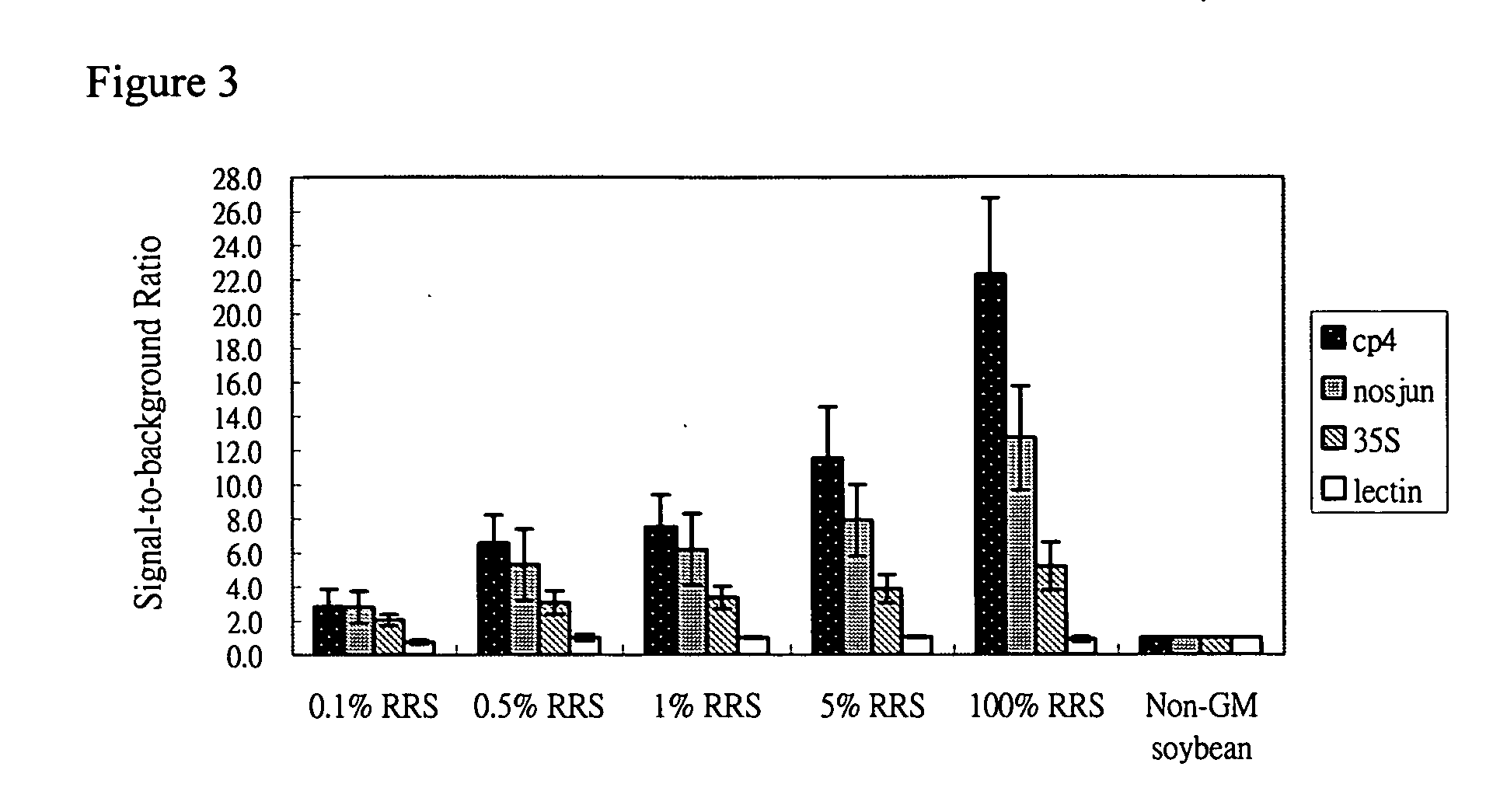Methods and kits for detecting genetically modified organism (GMO)
a technology kits, applied in the field of methods and kits for detecting genetically modified organisms, can solve the problems of harmful influence on people, high cost, and rapid increase of culture of genetically modified organisms with lack of legislative regulations and expectations
- Summary
- Abstract
- Description
- Claims
- Application Information
AI Technical Summary
Benefits of technology
Problems solved by technology
Method used
Image
Examples
example
Example 1
Extraction of Genomic DNA of Soybean by Using Qiagen DNeasy Plant Mini Kit
[0030] The tofu was cut into very small pieces. 100 mg tofu was added in a 1.5 ml microcentrifuge tube. All centrifugation steps are carried out at room temperature (15-25° C.). 400 μl buffer API were added into the tube, and the tube was vortexed vigorously. The tube was incubated at 65° C. for 10 min and was vortexed occasionally during incubation. If possible, 4 μl RNase A solution (100 mg / ml) as added and mixed. Then, 130 pl Buffer AP2 was added and the tube was mixed. The tube was incubated on ice for 5 min. The tube was centrifuged at 14,000 rpm (18,000×g) for 5 min. The lysate to a QIAshredder™ Spin Column sitting in a 2 ml collection tube was applied and centrifuged at maximum speed for 2 min. Transfer. flow-throw to new tube, add 1.5 fold of AP3 / E buffer and mix well. The mixer will apply to DNeasy Mini Column and centrifuged at 14,000 rpm (18,000×g) for 1 min. Wash with 500 μl of AW buffer...
example 2
Amplification of PCR Products
[0032] A new 0.2 ml tube was set up by adding up the reagents as follows:
ReagentsBrand Nameμlfinal conc.10x PCR bufferPROMEGA5 μl1X25 mM MgCl2PROMEGA4 μl2mM10 mM dNTP Mix.PROtech1 μl0.2mM each10 μM 35sF2 / R2Scino2 μl0.4μM(SEQ ID Nos. 1 and 2)10 μM nosjun-B-F1 / R1Scino2 μl0.4μM(SEQ ID Nos. 7 and 8)10 μM lecF2 / lecMP2Scino2 μl0.4μM(SEQ ID Nos. 9 and 10)10 μM cp4F1 / R1Scino5 μl1.0μM(SEQ ID Nos. 3 and 4) 5 U / μl TagPROMEGA0.3 μl 1.5UGenomic DNA100ng
Sterile water was to final volume 50 μl.
[0033] After all reagents were added into the tube, the following protocol was performed.
TemperatureTimeCycle number195° C. 5 min1295° C.30 sec3555° C.45 sec72° C.30 sec472° C. 5 min1
The test results were showed in FIG. 2.
example 3
Hybridization and Signal Detection
[0034] The probes were 35sP4 (SEQ ID No. 11), cp4P (SEQ ID No. 12), nosjunP1 (SEQ ID No. 14) and lecP3 (SEQ ID No. 15), respectively. These probes were coupled with carboxylated microsphere (MiraiBio Inc.) to form coupled probe.
[0035] 33 μl Hybridization buffer, 1 μl probe 35sP4 coupled bead, 1 μl probe cp4P coupled bead, 1 μl probe nosjunP1 coupled bead and 1 μl probe lecP3 coupled bead and 5 μl PCR product (0.1%, 0.5%, 1% and 5% of GM soybean content in the sample) or control groups (GM soybean for positive control and non-GM soybean for negative control) were added into 1.5 ml tube, then mixed completely by vortex. The reaction mixture was kept at 46° C. for 15 min. Then, Spin down at 14000 rpm for 3 min, discard supernatant. Add 50 ul 1X TMAC, vortex, Spin down at 14000 rpm for 3 min. After spin, remove supernatant and add 50 ul of 4 ug / ml SA-PE in 1x TMAC, incubated at dark and room temperature for 10 min. Transfer 50 ul to 96-well plate and ...
PUM
| Property | Measurement | Unit |
|---|---|---|
| temperature | aaaaa | aaaaa |
| volume | aaaaa | aaaaa |
| volumes | aaaaa | aaaaa |
Abstract
Description
Claims
Application Information
 Login to View More
Login to View More - R&D
- Intellectual Property
- Life Sciences
- Materials
- Tech Scout
- Unparalleled Data Quality
- Higher Quality Content
- 60% Fewer Hallucinations
Browse by: Latest US Patents, China's latest patents, Technical Efficacy Thesaurus, Application Domain, Technology Topic, Popular Technical Reports.
© 2025 PatSnap. All rights reserved.Legal|Privacy policy|Modern Slavery Act Transparency Statement|Sitemap|About US| Contact US: help@patsnap.com



